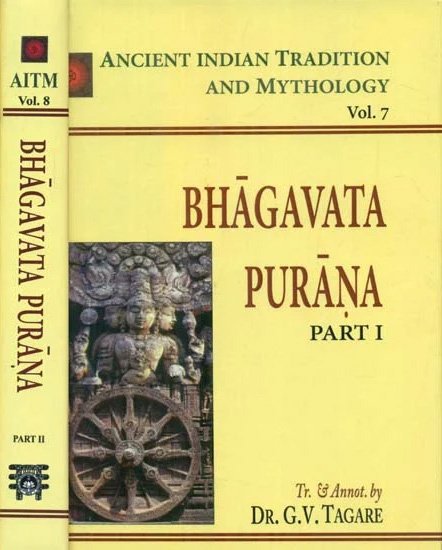The Bhagavata Purana
by G. V. Tagare | 1950 | 780,972 words | ISBN-10: 8120838203 | ISBN-13: 9788120838208
This page describes Notes regarding the Vyuhas (manifestations of God) of the English translation of the Bhagavata Purana, one of the eighteen major puranas containing roughly 18,000 metrical verses. Topics include ancient Indian history, religion, philosophy, geography, mythology, etc. The text has been interpreted by various schools of philosophy. This is the of the Appendices of the Bhagavatapurana.
Notes regarding the Vyūhas (manifestations of God)
Verse 21 (extracted from Chapter 26 of Book 3 the Bhāgavata Purāṇa):
यत्तत्सत्त्वगुणं स्वच्छं शान्तं भगवतः पदम् ।
यदाहुर्वासुदेवाख्यं चित्तं तन्महदात्मकम् ॥ २१ ॥yattatsattvaguṇaṃ svacchaṃ śāntaṃ bhagavataḥ padam |
yadāhurvāsudevākhyaṃ cittaṃ tanmahadātmakam || 21 ||“(It is well known in the āgamas) that Mahat which is characterised by sattva-guṇa, pure, free from passions (like love, hatred etc.) and the place of the Supreme Lord, is the citta which is called Vāsudeva and it is composed of Mahat Tattva”
Notes:
Bhāvāratha Dīpikā explains: From this verse the concept of the four vyūhas and how to worship them is given. Here what is considered from the causal or adhibhūta point of view is Mahat, the same is called citta from the point of adhyātma (relation to the body). It has Vāsudeva as an object of meditation (upāsya) and kṣetrajña as the presiding deity (adhiṣṭhātṛ).
It is a sort of a synthesis between the Sāṃkhya and the Pāñcarātra āgama. The four aspects of antaḥkaraṇa of the Sāṃkhyas are connected with the vyūhas (manifestations of God) of the Pāñcarātras as follows:
| Sāṃkhya as adhyātma (relating to body) | adhibhūta | Pāñcarātra upāsya (object of meditation) | adhiṣṭhātṛ (Presiding deity.) |
| 1. Citta | Mahat | Vāsudeva | Kṣetrajña (the Soul, occupant of the body) |
| 2. ahaṃkāra | Aggregate of bhūtas, senses and mind | Saṅkarṣaṇa | Rudra |
| 3. manas | manas | Aniruddha | Candra |
| 4. buddhi | buddhi (intellect) | Pradyumna | Brahmā |
The Pañcarātra idea of Vyūha is briefly as follows:
Vyūha is derived from √ūh with vi—‘to push, to remove, to thruts’ (Apte PSD 307). At the end of mahāpralaya, the following six attributes of God are manifested:
- jñāna (knowledge),
- aiśvarya (power),
- śakti (prowess),
- bala (supremacy),
- vīrya (energy) and
- tejas (splendour).
(They may be approximately rendered as:
- Knowledge—pure consciousness,
- Independence of activity,
- Potency to become the material cause of the world,
- Fatiguelessness and power to sustain,
- Unaffectedness,
- Selfsufficiency, splendour.
These six guṇas form the material of pure creation. The Vyūhas have a cosmological function while avatāras are concerned with the līlās.
The Vyūhas are four: Vāsudeva, Saṅkarṣaṇa, Pradyumna and Aniruddha, each having some cosmic functions. Their traditional representation may be summarised in the following table (vide the Sāttvata-Saṃhitā 5.9-18)
| 1: Vyūha: | Vāsudeva | Saṅkarṣaṇa | Pradyumna | Anirṇḍdha |
| 2. Prominent attributes | 1. Jñāna 2. aiśvarya 3. Śakti 4. bala 5. Vīrya 6. tejas |
1. Jñāna 2. aiśvarya — — — — |
— — 1. Śakti 2. bala — — |
— — — — 1. Vīrya 2. Tejas |
| 3. Complexion | Moon-white | Red-lead | The Sun’s rays | Collyrium-dark (like añjanādri) |
| 4. Colour of Garment | Yellow | Blue | Red | White |
| 5. Weapons etc. in 4 hands | All Vyūhas show abhaya-mudrā (assurance of protection) by the fourth hand and hold a conch in one. | |||
| 1. a Discus 2. a Mace |
1. a Plough 2. a Pestle |
1. a bow 2. arrows |
1. a sword 2. a Club |
|
| 6. Emblem on the banner | Garuḍa (an eagle) | Tāla (a palm tree) | Makara (a crocodile) | Mṛga (a deer) |
